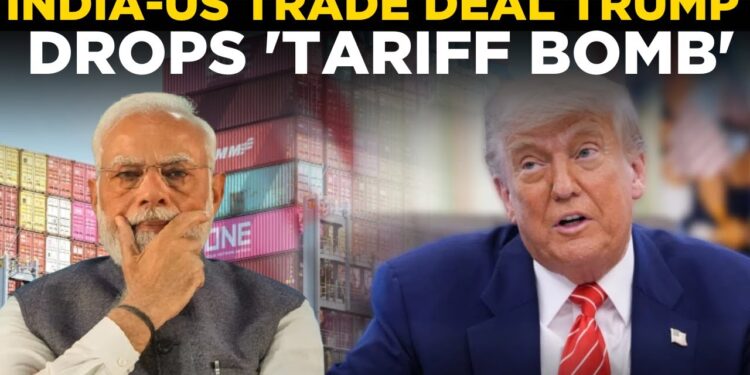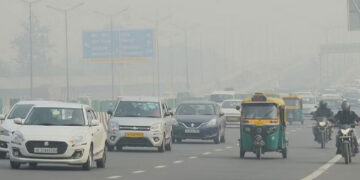
US Slaps 25% Tariff on India: In a move that has triggered international reactions, former US President Donald Trump announced revised tariff rates on imports from 69 countries, including India, ahead of his August 1 trade deadline. India faces a continued 25% tariff, while Pakistan sees its rates slashed from 29% to 19%. Trump’s remarks calling India a “dead economy” have also sparked controversy and firm responses from Indian authorities.
Commerce and Industry Minister Piyush Goyal addressed Parliament on Thursday, presenting India’s official stance and highlighting the country’s rapid economic rise, resilience, and commitment to protecting national interests.
India at 25% tariff: Negotiations Stalled Over Agriculture
Talks between India and the US reportedly stalled over the opening of India’s agriculture and dairy sectors—both economically and politically sensitive. As a result, goods from India are now subject to a 25% tariff, matching the rate set earlier in the Trump administration.
“The government attaches utmost importance to the welfare of our farmers, MSMEs, and exporters,” Goyal stated. “We will not compromise our national interest.”
Trump’s “Dead Economy” Jibe Triggers Outrage
Trump stirred tensions further by labelling India a “dead economy” in a Truth Social post, clubbing it with Russia. Referring to the recently announced 25% tariff, he wrote, “We’ve done very little business with India. Their tariffs are too high, among the highest in the world.”
In response, Goyal highlighted India’s global economic stature:
“India has transformed from one of the ‘Fragile Five’ to the world’s fastest growing major economy. We contribute nearly 16% to global growth,” he said.
India’s Economic Trajectory: Set to Become 3rd Largest
India, currently the world’s fifth-largest economy by nominal GDP, is expected to surpass Japan and Germany in the coming years, according to IMF estimates. Despite external challenges such as the recently imposed 25% tariff by the United States, Goyal credited India’s rise to structural reforms, innovation, and entrepreneurial spirit.
“We’ve risen from the 11th to among the top 5 economies. Soon, we will be the third largest,” he added, affirming confidence in India’s economic model.
Marching Toward Atmanirbhar Bharat
Goyal emphasized India’s commitment to self-reliance under the “Atmanirbhar Bharat” initiative, noting transformative policies and increased manufacturing capacities.
“Our youth, our startups, and our industries are driving innovation and global competitiveness. India is ready to lead the future of manufacturing,” he asserted.
India Open to Fair Trade Deals, But Not at Any Cost
While India is open to trade agreements, Goyal clarified that they must be mutually beneficial. “We have successfully signed deals with UAE, Australia, and the EFTA nations. Talks with the US have continued since March, and we’re open to constructive engagement.”
India is also expecting a delegation from the US later this month for the sixth round of trade talks. However, tensions remain due to Trump’s additional threats over India’s continued oil trade with Russia.
Global Reactions and Implications
Many analysts see the 25% tariff decision on India as politically motivated ahead of the US elections. Trump also raised tariffs to 50% for Brazil and 35% for Canada, while granting Mexico a 90-day reprieve.
In contrast, Pakistan’s reduced tariff has surprised foreign policy experts, especially in light of Trump’s recent offer to help Islamabad build strategic oil reserves.
New US Tariff List (Effective August 2025)
| Tariff Rate | Countries / Territories |
|---|---|
| 41% | Syria |
| 40% | Myanmar (Burma), Laos |
| 39% | Switzerland |
| 35% | Iraq, Serbia, Canada (on fentanyl-related goods) |
| 30% | Algeria, Bosnia & Herzegovina, Libya, South Africa |
| 29% → 19% | Pakistan (reduced) |
| 25% | India, Brunei, Kazakhstan, Tunisia, Moldova |
| 20% | Bangladesh, Sri Lanka, Taiwan, Vietnam |
| 19% | Indonesia, Malaysia, Cambodia, Philippines |
| 18% | Nicaragua |
| 15% (standard rate) | Afghanistan, Angola, Bolivia, Botswana, Cameroon, Chad, Costa Rica, Côte d’Ivoire, DRC, Ecuador, Equatorial Guinea, Fiji, Ghana, Guyana, Iceland, Israel, Japan, Jordan, Lesotho, Liechtenstein, Madagascar, Malawi, Mauritius, Mozambique, Namibia, Nauru, New Zealand, Nigeria, North Macedonia, Norway, Papua New Guinea, Trinidad & Tobago, Turkey, Uganda, Vanuatu, Venezuela, Zambia, Zimbabwe |
| 10% | Brazil (general), United Kingdom, Falkland Islands |
| 0% | European Union (goods with Column 1 duty rate >15%) |
| Variable | European Union (goods with duty <15%): 15% minus Column 1 duty rate |
India’s Clear Message to the World
Summarizing India’s position, Commerce Minister Piyush Goyal firmly stated, “India’s economy is alive, vibrant, and inclusive. Our policies reflect the will and welfare of 1.4 billion people. No external pressure will determine our trade decisions.”
Goyal emphasized that India will not be bullied into trade deals that compromise its sovereignty or economic priorities. Referring to the recently imposed 25% tariff by the United States, he said such measures would not deter India from protecting its core sectors. He pointed out that the country’s trade strategy is not reactive but principled, based on long-term growth, self-reliance, and equitable benefit to all sectors—especially farmers, MSMEs, and small exporters.
He reiterated that while India is open to cooperation, every agreement must be mutually beneficial. “We are committed to strengthening our global partnerships—but on our terms. We welcome investment, innovation, and fair trade, but will never allow foreign pressure to dictate our domestic policies.”
This strong message was intended not just for the US, but for the global community observing the current tensions. As India prepares for upcoming trade talks with US officials later this month, the government has made it clear that the 25% tariff will not alter its commitment to policies rooted in respect, parity, and shared prosperity in international negotiations.
















